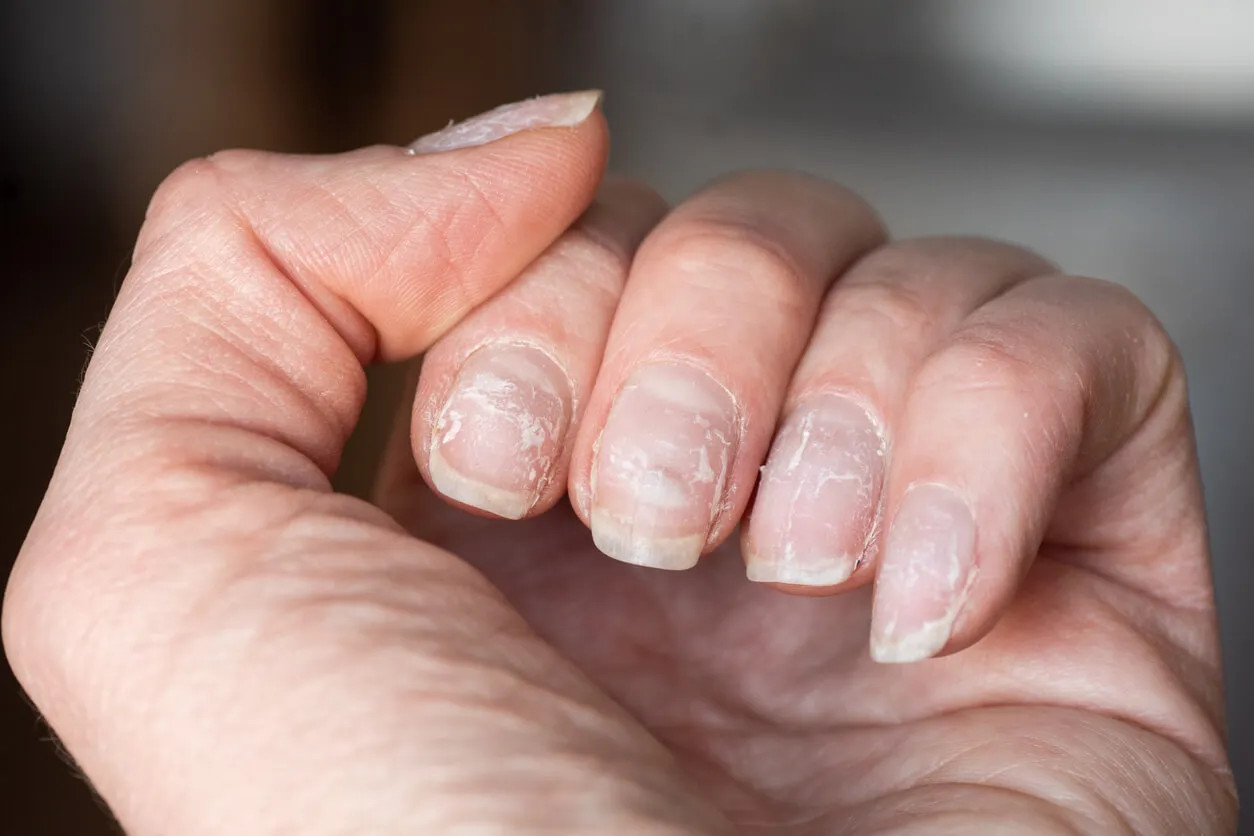Why Do Stretch Marks Appear on the Nails?

Stretch marks on the nails don’t cause any difficulty beyond the subjective aesthetic discomfort they may cause in some people. In and of themselves, they should not be a cause for concern. However, sometimes they may be an indicator of something else.
Certain bad habits and health problems can manifest themselves through this symptom. Since it’s not useful for a diagnosis on its own, it’s key to be on the lookout for other clinical manifestations. In certain cases, hormonal fluctuations and a lack of certain nutrients explain this situation. What other causes are there? Let’s take a closer look.
Nail striae or ridges
Nails are composed of about 150 layers, all of which are made of keratin. Some are superimposed on top of others, but sometimes they become detached. This gives rise to nail ridges, whose technical name is “nail striae.”
They’re often horizontal or vertical. They look like small channels and can be more or less deep. They may also be accompanied by dents or small dots, as if a hole had been made with a pin.
In some cases, this is due to a nail health problem. However, it may also suggest difficulties in other parts of the body.

Why do stretch marks appear on the nails?
Stretch marks on the nails are lesions in the form of grooves. They arise from a break in the structure of the nail, just as stretch marks on the skin are a break in the skin tissue. If they’re regular and not very deep, they’re considered irrelevant.
Vertical stretch marks
If the stretch marks are vertical, they’re most likely due to natural aging. However, they may also be associated with one of the following problems:
- A lack of vitamins, particularly vitamins A and B
- Dehydration
- The tendency to have dry skin
- Nail-biting
- Excessive manicures
- Continuous contact with aggressive chemicals such as those present in cleaning products, cosmetics, or tobacco
- Constant stress
- The use of artificial nails that use aggressive glues
- Genetic causes
- Inadequate use of scissors or nail clipper
- Heller’s median canaliform nail dystrophy: This is produced by repeated blows on the nails. It forms an open channel right in the middle of the nail.
These types of nail ridges may also be associated with more serious health problems such as lichen planus or rheumatoid arthritis, especially if there’s pain or color change. They may also be the result of an injury.
Horizontal striae
Meanwhile, horizontal stretch marks, also known as “Beau’s lines,” are almost always due to a temporary slowing of nail growth. This can be caused by trauma or by conditions such as those mentioned below:
- Peripheral vascular disease
- Uncontrolled diabetes mellitus
- Conditions associated with high fever, such as measles, pneumonia, scarlet fever, or mumps
- A zinc deficiency
- Hypothyroidism
- Tumors in the nail birth zone
We think you may also enjoy reading this article: 5 Treatments With Coconut Oil to Reduce Stretch Marks and Scars
How to treat nail stretch marks
As is often the case, the treatment of nail stretch marks will depend on the cause that produces them. A distinction should be made here: one thing is to treat the stretch marks themselves to improve the appearance of the nail, and another is to establish the cause of the problem and treat it.
In general, when they are superficial and regular, it’s possible to take some simple measures to repair them. The most recommended are the following:
- A nail smoothing treatment. This consists of polishing done by a manicurist in order to smooth the nail and eliminate the grooves. It’s only advisable when the stretch marks aren’t deep and the nail isn’t very thin.
- Oils. You can use warm olive, almond, or coconut oil. It’s only necessary to soak the nails for a few minutes in this substance and then massage them. If done on a regular basis, it’s possible to fade or eliminate stretch marks on the nails.
- Fill in the grooves. This is done with an anti-stretch mark polish base. It’s usually carried out when a polish is to be applied on top. The final finish is smooth.
- Water-soluble nail polish with horsetail. This is a special product that provides silicon and sulfur, which penetrate the nail and restore it. It also strengthens the nail. This treatment usually lasts only two weeks.
If there are doubts or concerns about the causes that give rise to stretch marks on the nails, the most indicated is to consult a doctor or dermatologist to check the state of your health in general.
The prevention of stretch marks on the nails
This symptom can also be prevented and, as always, this is the best option. It’s enough to adopt some healthy habits and apply certain care on a regular basis. The recommendations are as follows:
- Regularly consume fruits and vegetables. They provide vitamins A and B, as well as minerals such as zinc, calcium, and magnesium, among others, which promote good nail health.
- Drink water frequently.
- Consume a diet that’s abundant in protein.
- Cut your nails with the right tools and in the right way.
- Use cardboard files.
- Wear gloves when working with aggressive chemicals.
- Moisturize your nails with creams or oils.
- Don’t use semi-permanent nail polish continuously.
- Use oily nail polish removers.
- Avoid shocks or injuries.
- Avoid hot water on the nails.

Like this article? You may also like to read: Make a Scrub for Stretch Marks with Coffee and Coconut Oil
Final recommendations
Despite the application of all the recommendations we have given, in many cases, it’s not possible to eliminate nail stretch marks completely. However, making them a part of your daily routine will allow you to reduce them as much as possible until they become almost invisible.
In any case, if in addition to this symptom, there’s any discomfort, the shape becomes strange, there are changes in coloration or the appearance of your nail isn’t normal, the right thing to do is to talk to the doctor. A professional will know how to intervene in the best way.
All cited sources were thoroughly reviewed by our team to ensure their quality, reliability, currency, and validity. The bibliography of this article was considered reliable and of academic or scientific accuracy.
- Cano, L. P. R. (2012). Queratina: la proteína protectora. MoleQla: revista de Ciencias de la Universidad Pablo de Olavide, (6), 10-13.
- Martin, B. (2013). Histopatología de la uña. Actas Dermo-Sifiliográficas, 104(7), 564-578.
- Cashman MW, Sloan SB. Nutrition and nail disease. Clin Dermatol. 2010 Jul-Aug;28(4):420-5. doi: 10.1016/j.clindermatol.2010.03.037. PMID: 20620759.
- Madke B, Gadkari R, Nayak C. Median canaliform dystrophy of Heller. Indian Dermatol Online J. 2012;3(3):224-225. doi:10.4103/2229-5178.101832
- Lorenzo, V. O. (2021). El lenguaje de las uñas. El farmacéutico: profesión y cultura, (598), 28-32.
-
Cantoresi F, Sorgi P, Arcese A, Bidoli A, Bruni F, Carnevale C, Calvieri S. Improvement of psoriatic onychodystrophy by a water-soluble nail lacquer. J Eur Acad Dermatol Venereol. 2009 Jul;23(7):832-4. doi: 10.1111/j.1468-3083.2009.03209.x. Epub 2009 Apr 8. PMID: 19470045.
This text is provided for informational purposes only and does not replace consultation with a professional. If in doubt, consult your specialist.








